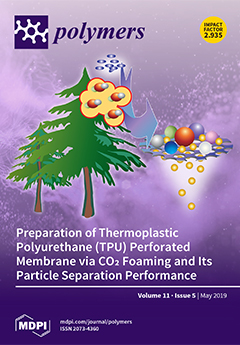Herein, we investigated novel carbon-containing P123 copolymer-activated boron nitride whiskers (P123-CBNW) fabricated via a structure directing approach followed by a single-step heat treatment under N
2. The resulting materials were found to be highly micro- and mesoporous. The influence of the activating
[...] Read more.
Herein, we investigated novel carbon-containing P123 copolymer-activated boron nitride whiskers (P123-CBNW) fabricated via a structure directing approach followed by a single-step heat treatment under N
2. The resulting materials were found to be highly micro- and mesoporous. The influence of the activating agent (P123 copolymer) on the CO
2 adsorption efficiency was determined. The prepared samples possessed high specific surface areas (594–1732 m
2/g) and micropore volumes (0.258–0.672 cm
3/g). The maximum CO
2 uptakes of the prepared adsorbents were in the range 136–308 mg/g (3.09–7.01 mmol/g) at 273 K and 1 bar and 97–114 mg/g (2.22–4.62 mmol/g) in the following order: CBNW < P123-CBNW3 < P123-CBNW2 < P123-CBNW1 < P123-CBNW0.5. The isosteric heat of adsorption values (∆
Qst) were found to be 33.7–43.7 kJ/mol, demonstrating the physisorption nature of the CO
2 adsorption. Extensive analysis revealed that the presence of carbon, the high specific surface area, the high microporosity, and the chemical structural defects within the adsorbents are responsible for raising the CO
2 adsorption ability and the selectivity over N
2 gas. The fabricated adsorbents show excellent regeneration ability after several repeated adsorption cycles, making the prepared adsorbents promising candidates for gas storage applications.
Full article






